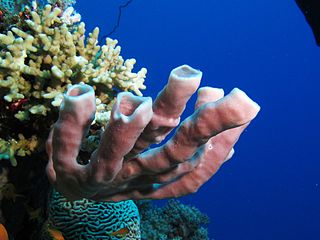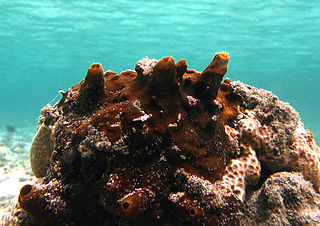
Lendenfeld Peak, in the past also Mount Lendenfeld, is the eighth highest named summit in New Zealand and in Aoraki / Mount Cook National Park.

Tethya is a genus of sea sponges belonging to the family Tethyidae. Members of this genus all have a spherical body form and some are known to be able to move at speeds of between 1 and 4 mm per day.

Ancorinidae is a family of marine sponges belonging to the order of Tetractinellida.

Callyspongiidae is a family of sea sponges in the order Haplosclerida. It contains the following genera and species:
Geodia acanthylastra is a sponge species from the family Geodiidae. The species is found in the waters of the Pacific Ocean off the coast of California and was first described by Robert Lendenfeld in 1910.

Aplysina is a genus of sea sponges in the order Verongiida. It was first authenticated and described by Giovanni Domenico Nardo in 1834.

Thorectidae is a family of sea sponges in the order Dictyoceratida.
Dactylia elegans is a species of demosponges in the family Callyspongiidae. It is found in Western Australia.
Geodia agassizi is a species of sponge in the family Geodiidae. The species is found in the eastern tropical Pacific Ocean and was first described by Robert Lendenfeld in 1910.
Lychnorhizidae is a family of true jellyfish.
Geodia breviana is a species of sponge in the family Geodiidae. It is found in the waters of the Pacific Ocean off the coast of California. It was first described by Robert J. Lendlmayer von Lendenfeld in 1910.
Geodia amphistrongyla is a species of sponge in the family Geodiidae. The species is found in the tropical Pacific Ocean and was first described by Robert J. Lendlmayer von Lendenfeld in 1910.
Geodia carcinophila is a species of sponge in the family Geodiidae. It was first described by Lendenfeld in 1897. It is found in the waters of the Somali Sea around the Zanzibar Archipelago.
Geodia ataxastra is a species of sponge in the family Geodiidae. It is found in the waters of the Pacific Ocean near the coasts of Panama and Colombia. The species was first described by Robert J. Lendlmayer von Lendenfeld in 1910.
Geodia erinacea is a species of sponge in the family Geodiidae. The species was first described by Lendenfeld in 1888. It is found in all the coastal waters of Australia.
Geodia gallica is a species of sponge in the family Geodiidae. The species was first described by Lendenfeld in 1907. It is found in the coastal waters of Agulhas Bank, next to South Africa.

Theonellidae is a family of sponges belonging to the order Tetractinellida, which was first described by Robert von Lendenfeld in 1903.
Pseudorhiza is a genus of cnidarians belonging to the family Lychnorhizidae.

Spheciospongia is a genus of sponges belonging to the family Clionaidae.
Pseudorhiza haeckeli, or Haeckel's jelly, is a species of cnidarian of the family Lychnorhizidae. The species is a carnivore with a mild sting. It is native to temperate and sub-tropical Australian marine waters. It has been observed at depths of 1-30 metres, and is sometimes found cast on beaches. It was described by the naturalist Wilhelm Haacke in 1884, and named for his mentor Ernst Haeckel.







